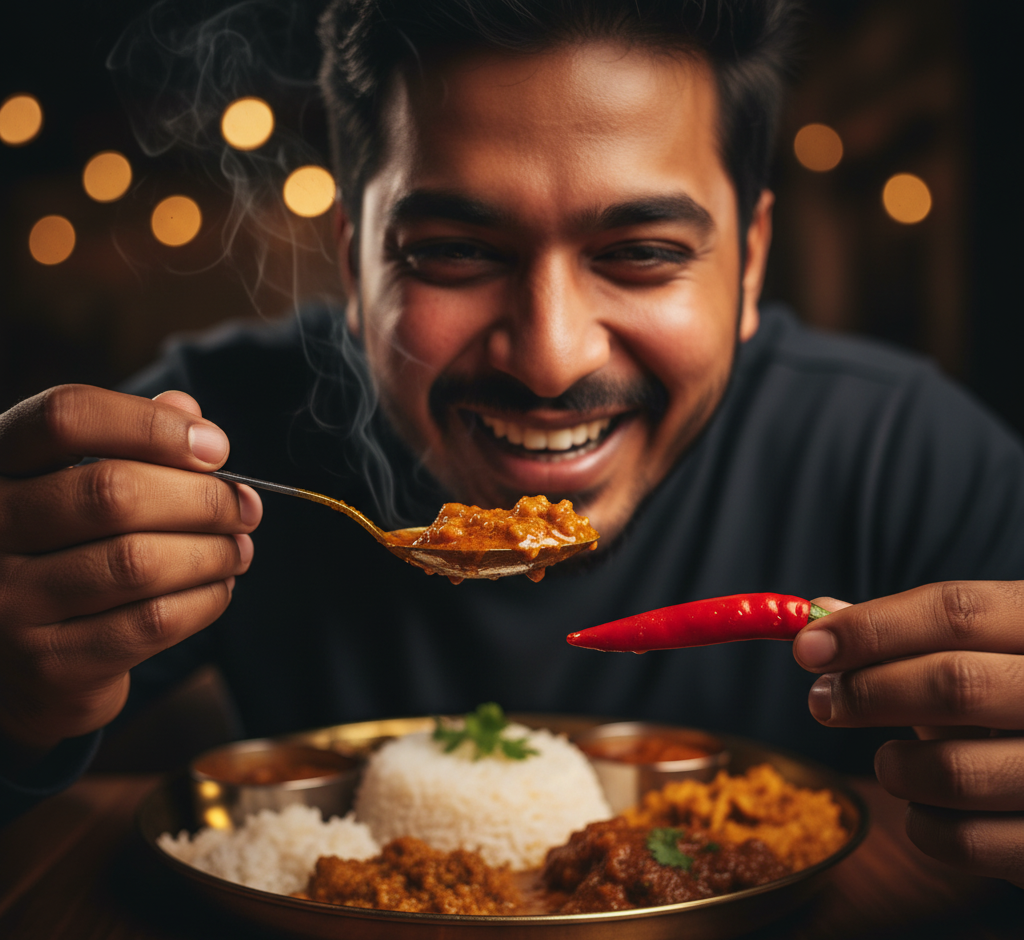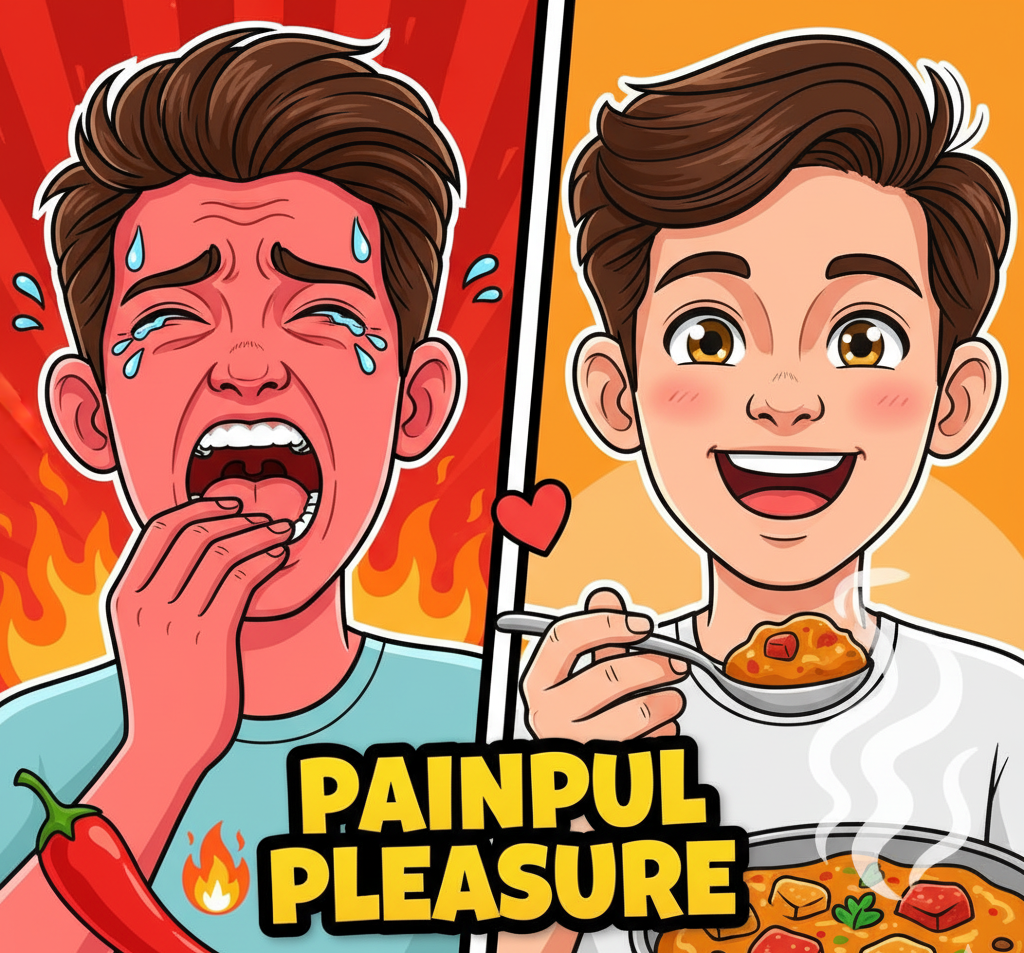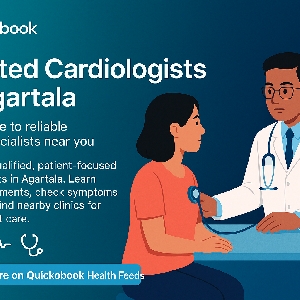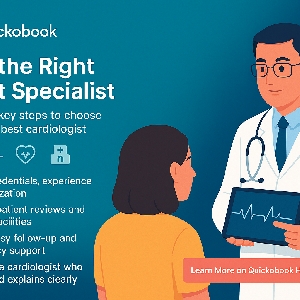Introduction
Spicy food is a love story full of heat, thrill, and flavor. From the fiery curries of India to the tongue-tingling sauces of Mexico, people across the world enjoy foods that make them sweat, tear up, and even cry. But why do we love this pain so much? The secret lies in our body’s fascinating reaction to capsaicin, the chemical that gives chili peppers their heat.
In India, where spice is part of culinary identity, many people even take part in hot food challenges to test their spice tolerance. Let’s explore why spice excites our taste buds, what happens inside our body when we eat it, and whether it’s actually good for health.

What Makes Spicy Food ‘Spicy’?
The main ingredient behind the burning sensation is capsaicin, a natural compound found in chili peppers. Capsaicin binds to the TRPV1 receptors on your tongue and mouth — the same receptors that detect heat and pain. Your brain interprets this as burning, even though there’s no real temperature rise.
Interestingly, capsaicin doesn’t cause actual damage; it simply tricks the nervous system into thinking your mouth is on fire. This unique reaction explains why eating spicy food feels painful yet strangely enjoyable.
The Science Behind the Pleasure
So why do people keep eating something that “hurts”? The answer lies in the brain’s reward system. When capsaicin triggers pain, your brain releases endorphins and dopamine, the body’s natural feel-good chemicals.
These hormones reduce pain and create a mild “high,” similar to what runners experience after intense workouts. This euphoric reaction can become addictive — explaining why some people keep seeking hotter and hotter foods or join hot food challenges.
Cultural and Psychological Factors
Spice as Identity in Indian Cuisine
In India, spice isn’t just about heat — it’s about heritage and flavor balance. Every region uses chilies differently:
-
South India: fiery curries with red chilies
-
North India: rich gravies with black pepper and green chilies
-
Northeast India: unique use of “bhut jolokia” (ghost pepper), one of the world’s hottest chilies
Spice often symbolizes strength and endurance. Eating spicy food is also a way to showcase tolerance, pride, and sometimes even bravery — especially during street-side hot food challenges or viral “spice tests” on social media.
The Psychology of Pain and Reward
Humans are wired to enjoy safe thrills — activities that simulate danger but don’t harm us, like roller coasters or horror movies. Spicy food offers a similar thrill. It’s “safe pain,” giving a rush without real risk.
This explains why people compete to eat spicier dishes — it’s not just about taste, but about adrenaline, status, and excitement.

ALSO READ:World Immunization Day 2025: Expanding Adult Vaccines To Guard India's Health
Health Benefits of Spicy Food
Despite the temporary discomfort, spicy foods can offer several benefits when eaten in moderation:
-
Boosts metabolism by raising body temperature
-
Improves digestion by stimulating gastric juices
-
Reduces inflammation naturally
-
Supports heart health and circulation
-
Fights infections due to high vitamin C content
-
Enhances mood and reduces stress through endorphin release
Can Spicy Food Be Harmful?
Too much of anything can cause trouble. Overindulging in spice can lead to:
-
Acid reflux or heartburn
-
Stomach irritation
-
Burning sensation in the mouth or throat
-
Worsening of ulcers or gastritis
People with sensitive stomachs should eat spice in moderation and avoid excessive chili intake. Drinking milk or yogurt after spicy food can help neutralize the burn, as dairy binds with capsaicin more effectively than water.
Why Spicy Food Feels Addictive
When your body gets used to the rush of endorphins from spicy meals, it starts craving that feeling again. This is why spice lovers often find mild foods boring. Over time, your spice tolerance grows, and you may need hotter chilies to experience the same thrill — just like increasing difficulty levels in a challenge.

How to Build Spice Tolerance Safely
-
Start small with mildly spicy foods like black pepper or paprika
-
Gradually move up to green and red chilies
-
Combine spicy food with cooling sides like curd, ghee, or rice
-
Stay hydrated and avoid spice on an empty stomach
-
Listen to your body — stop when it feels too uncomfortable
Spicy Food and Indian Hot Food Challenges
From roadside “mirchi bada” contests to YouTube chili-eating battles, Indians take pride in their spice stamina. These hot food challenges are more than entertainment — they represent community spirit, courage, and cultural connection.
However, participants should be cautious. Eating extremely spicy food quickly can cause burning, vomiting, or stomach distress. Always hydrate and avoid competing on an empty stomach.
Tips for Managing Spice Burn
-
Drink milk: Casein in milk breaks down capsaicin
-
Eat bread or rice: Starches absorb chili oils
-
Avoid water: It spreads the burn instead of cooling it
-
Use sugar or honey: Sweetness can calm the fire
-
Cool with yogurt: A traditional Indian remedy for chili burn
When to See a Doctor
If you experience severe symptoms like persistent stomach pain, ulcers, or acid reflux after eating spicy foods, consult a general physician. You can easily find a trusted GP near you on Quickobook, where you can book appointments online, get teleconsultations, and access verified medical professionals across India.
Conclusion
Spicy food is more than just heat — it’s a sensory adventure that excites, challenges, and connects people. The love for spice lies at the intersection of biology, psychology, and culture. Whether you enjoy a mild kick or chase the hottest chili on earth, the thrill of spice is a universal experience that turns pain into pleasure.
Eat responsibly, enjoy the flavors, and remember — sometimes, life’s best pleasures come with a little burn!
Quickobook Call to Action
If spicy food gives you acidity, heartburn, or stomach pain, don’t ignore it. Book an appointment with a General Physician or Gastroenterologist on Quickobook.com. Get expert advice, prescriptions, and care from the comfort of your home.
Stay safe. Stay healthy. Stay spicy!
50 FAQs About Spicy Food and Health
Q1. Why does spicy food feel hot?
A. Because capsaicin activates pain receptors that sense heat, even though the food isn’t actually hot.
Q2. Is eating spicy food bad for health?
A. Not usually. Moderate spice can boost metabolism, but excessive intake can cause stomach issues.
Q3. Why do Indians eat so much spicy food?
A. It’s cultural — spices add flavor, aid digestion, and act as natural preservatives.
Q4. What is the chemical that makes chilies hot?
A. Capsaicin.
Q5. Can spicy food cause ulcers?
A. It doesn’t cause ulcers directly, but can irritate existing ones.
Q6. How can I reduce the burning after spicy food?
A. Drink milk or eat curd to neutralize capsaicin.
Q7. Do spicy foods cause acne?
A. Not directly, but they may trigger breakouts in sensitive people.
Q8. Are there health benefits to eating spicy food?
A. Yes. It can boost metabolism, reduce inflammation, and improve heart health.
Q9. Why do people enjoy pain from spicy food?
A. The brain releases endorphins that create a pleasurable “high.”
Q10. What are hot food challenges?
A. Competitions where participants eat extremely spicy food for fun or records.
Q11. Can spicy food cause stomach pain?
A. Yes, if consumed in large quantities or on an empty stomach.
Q12. How does milk stop the burn?
A. Casein in milk binds to capsaicin and washes it away.
Q13. What are the hottest chilies in India?
A. Bhut Jolokia (Ghost Pepper) and Naga Morich.
Q14. How can I build tolerance to spicy food?
A. Gradually increase spice levels in your diet over time.
Q15. Can children eat spicy food?
A. Mild spices are fine; too much heat may upset their stomach.
Q16. Does spicy food cause heartburn?
A. Yes, for people prone to acid reflux.
Q17. Can spicy food help you lose weight?
A. It can slightly boost metabolism, aiding calorie burn.
Q18. Why does my nose run when I eat spicy food?
A. Spice triggers mucus production as part of the body’s cooling response.
Q19. What drink helps with spicy food?
A. Milk, lassi, or yogurt-based drinks work best.
Q20. Do spicy foods cause cancer?
A. No direct link, though excessive fried spicy foods may raise risk.
Q21. Are all peppers spicy?
A. No, bell peppers contain little or no capsaicin.
Q22. Can spicy food affect sleep?
A. Yes, eating spice late at night may cause indigestion.
Q23. Is spicy food good for the heart?
A. Yes, studies show it can improve circulation and cholesterol levels.
Q24. What happens if I eat too much chili?
A. You may experience nausea, stomach cramps, or heartburn.
Q25. Does spicy food kill bacteria?
A. It can slow bacterial growth, helping preserve food.
Q26. Can spicy food make you happy?
A. Yes, endorphin release boosts mood.
Q27. Is spicy food safe during pregnancy?
A. Generally safe, but avoid if it causes heartburn.
Q28. Why does spicy food make me sweat?
A. It activates heat receptors that trigger cooling mechanisms.
Q29. Does spice tolerance vary by genetics?
A. Yes, some people have more sensitive heat receptors.
Q30. Can spicy food clear sinuses?
A. Yes, temporarily by opening nasal passages.
Q31. Why do my lips burn after chili?
A. Capsaicin irritates nerve endings around the mouth.
Q32. Does cooking reduce chili heat?
A. Slightly, but not completely.
Q33. Is spicy food addictive?
A. Yes, because of endorphin release.
Q34. Can spicy food cause diarrhea?
A. It may, especially in people with sensitive stomachs.
Q35. Is spicy food good for colds?
A. It can help relieve congestion temporarily.
Q36. Can I eat spicy food every day?
A. Yes, if your stomach tolerates it.
Q37. Does spice kill taste buds?
A. No, it only overstimulates them temporarily.
Q38. Can spicy food trigger headaches?
A. Yes, in some people sensitive to capsaicin.
Q39. Are there side effects of too much chili?
A. Burning, nausea, and acid reflux.
Q40. How to calm a burning tongue?
A. Drink milk or eat sugar.
Q41. What foods pair well with spice?
A. Rice, yogurt, bread, and cooling salads.
Q42. Why do people join hot food challenges?
A. For thrill, competition, and fun.
Q43. Can spicy food cause coughing?
A. Yes, due to irritation of the throat.
Q44. How to measure chili heat?
A. Using the Scoville Scale.
Q45. Does spicy food spoil faster?
A. No, spice can act as a natural preservative.
Q46. Can spicy food affect skin?
A. Sometimes, due to heat-induced flushing.
Q47. Why does my stomach burn after spicy food?
A. Excess acid production or irritation of stomach lining.
Q48. Is spicy food good for digestion?
A. In moderation, yes — it boosts enzyme flow.
Q49. Can I train myself to love spicy food?
A. Yes, through gradual exposure.
Q50. When should I see a doctor after eating spicy food?
A. If you have persistent pain, ulcers, or vomiting — consult a GP via Quickobook.









Comments (0)
No comments yet. Be the first to share your thoughts!
Leave a Comment